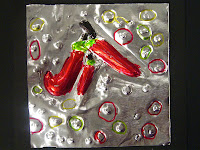 The weather is getting colder, and we're hoping for snow in Texas!
The weather is getting colder, and we're hoping for snow in Texas!Like many other things in nature, snowflakes have radial symmetry, which means that they're the same all the way around. To learn more about radial symmetry check out this informative slideshow:
Radial symmetry
View more PowerPoint from Nancy Walkup
In first grade, we used paper and scissors to create snowflakes that are the same all the way around.
Although the each have radial symmetry, no two snowflakes are alike and neither are our artworks!

















































